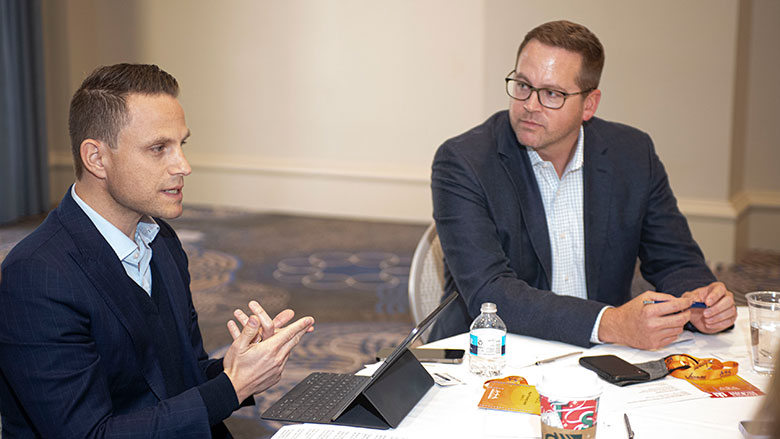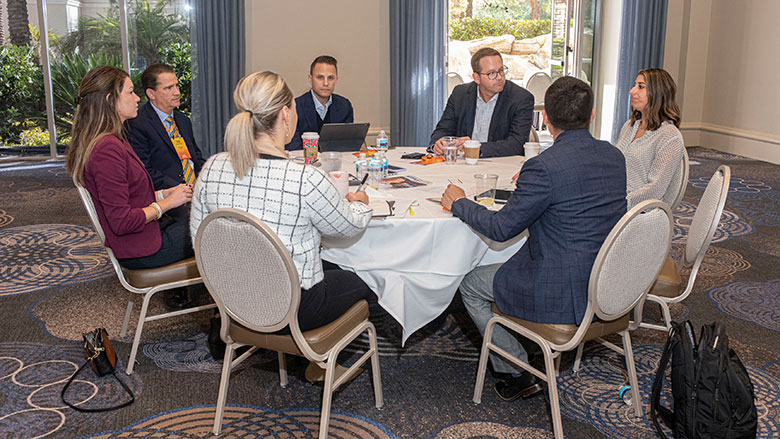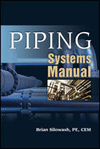American Supply Association members were itching to get back to an in-person NETWORK conference, and the 2021 event in Las Vegas certainly delivered the networking, education and reconnecting that the more than 700 attendees were after.
Each year at NETWORK, ASA and Supply House Times coordinate an exclusive distributor roundtable discussion to obtain a pulse for the marketplace and tackle hot-button topics most relevant to today’s supply chain. A summary of the interview is published in two parts. Be on the lookout for Part 2 coming in the February issue.
This diverse group of five participants includes roles from executive and marketing to purchasing and inventory experts. After the nearly three-hour conversation, it was clear one thing is for certain; the current supply chain status and high-demand calls for an all-hands-on-deck approach.
Solid business, slim supply
Kicking things off with an easy question, “How is business overall?” Distributors agreed that demand is high and being busy is an understatement.
“In 2020 and early 2021, there was so much uncertainty. Uncertainty surrounding the vaccine's efficacy, the presidential election, the economy, labor and material shortages, a second wave of COVID and more,” said Jeff Wool, executive vice president of Florida-based plumbing and bath and kitchen distributor Wool Plumbing Supply. “With all of that considered, demand and overall business this year has been exceeding expectations. We continue to see demand stemming from the influx of people relocating to South Florida from other states, in addition to clients who have decided to remodel after staying in their homes more.”
Debbie Gorra, profit center manager for Weinstein Supply, a northeastern division of Hajoca, agreed. “Our customer base is busy,” she said. “The housing shortage continues to create demand for new construction, and the remodeling market is very active as well.”
Likewise, the Midwest is also experiencing increased demand. “Overall, we have had a great year,” said First Supply’s Chief Strategy Officer Seth DePuy. “Business in the repair and remodel markets as well as new construction has remained solid. Inflation has boosted revenue figures, but when we look at units out the door, it has been a very successful year.”


Jeremy Fuller, inventory and purchasing manager for Texas Plumbing Supply, pointed out the company will finish 2021 with record numbers. “We’re going to finish with a record year in terms of both sales and total purchases,” he said. “We track value-received and units-received pretty closely, and even with vendors having the hardest time getting us product, for the most part, we're actually up in terms of units over last year with many partners.”
Addison, Illinois-based Porter Pipe & Supply’s Director of Brand and Marketing, Stephanie Porter, agreed, adding that there are two main concerns looming, despite overall positive business. “It’s a blessing to be able to say that we’ve had such a strong year after all the challenges we faced last year,” she said. “In the environment we’re navigating, everyone is struggling to find product and/or labor. Those are the greatest challenges among all industries, not just ours.”
Fuller added internal allocations have been helpful in navigating the current supply chain disruption. “We’ve been extremely active with our own internal allocations, which we've never had to do previously,” he explained. “Managing that has helped us to continue to grow, maintain partnerships, and keep and build solid relationships with our contractor partners.”
Talking about particularly fruitful sectors of the market, Porter said nickel-based iron and stainless products were winners for Porter Pipe in 2021, and data center and hospital jobs were plentiful throughout the year.
DePuy said residential new construction, repair and remodel, HVAC and waterworks have all been in high demand. “Most segments of our business have been running on all cylinders,” he said. “We have supplied product to many school projects as well, stemming from referendums passed a few years back.”
Gorra noted PVC pipe and fittings have been making increased headway within the new construction market.
The panelists agreed that they aren’t experiencing a slowdown in any sectors throughout their markets.
“There aren’t many projects in the hospitality sector, but commercial real estate and warehousing projects are popping up everywhere,” Fuller said.
Limited supply is leading to material and product price inflation, and First Supply’s DePuy noted concern for the value of product moving forward. “My concern with inflation is how it's affecting the value of product. When you talk about a piece of pipe, what is that actual piece of pipe worth? Right now it's inflated, so there are a lot of uncertainties surrounding the ability to fund projects in the future.”
Vendor relations, customer response
At this point, disruption is no surprise. The important question is: How are customers and vendors dealing with and responding to backordered projects, allocations and delayed project timelines?
Porter said many customers are buying in bulk due to supply chain constraints and rising prices. “One of the biggest differentiators we've seen is that customers are not as worried about product price as much as they used to be,” she said. “They just want the product ready on-hand when they need it. If they don't have the space to store it in the interim, they're hoping we can hold it and store it for them.”
Distributors mentioned price increases becoming less concerning than they were initially.
“We were initially concerned with presenting frequent price increases, some of which were significant and unprecedented,” Wool said. “We quickly realized that customers were more concerned with actually getting their hands on products and less concerned with the price.”
When working with contractor customers, DePuy mentioned being concerned about the bandwidth available to keep track of price changes. “One of my main concerns is that our customers may not be utilizing the most updated pricing when quoting and winning projects. The industry has experienced double-digit price increases in every product category this year, with many of those increases taking effect immediately. How can a contractor accurately price a project when prices constantly change?”
Noting that the current disruption is a new reality, Gorra said you have to “get creative and hustle.”
“At Hajoca, the mindset is to do whatever and work with whoever to get things done for your customer,” Gorra added. “A silver lining from all this is it has been rekindling vendor relationships that may not have been as strong and forming deeper relationships with all our vendors. As long as we can come up with a fair solution and keep customers happy, it’s a win-win”
Broadening vendor relationships is a common theme among distributors. Fuller said having solid secondary vendor sources has proven beneficial.
“For a very long time, we focused on one primary source for a product. Over the past few years — between Hurricane Harvey, the Texas freeze and COVID — we’ve started investing in a solid secondary source,” he explained. “Nurturing multiple relationships has allowed us to leverage and reap the benefits of different relationships when needed, and our business has grown enough so we can do this without negatively impacting our primary source.”
According to these distributors, encouraging customers to purchase further in advance and maintaining honest communication are key to navigating this market.
“We have focused on having honest dialogue with our customers in regard to the supply chain challenges,” DePuy said. “If a customer has a project that requires a significant amount of product, we encourage them to bring manufacturers and us in the loop as soon as possible so we can do everything in our power to meet project demands. If anything is certain, there is no such things as over-communication throughout these times.”
Porter added that customers are asking for price protection more than ever as they expect demand to continue to rise and price to mirror it.
Increasing communication with customers has been a lot about educating them as well. “We educate customers as much as we can about the market conditions. We try to get increased letters out to them as soon as we know about them,” Fuller said.
Fuller added that customer demand and price increases can be a recipe for internal struggle. “We’ve had to work to manage those relationships between purchasing and branch managers and the sales teams,” he said. “We all get frustrated; we have to remember that ultimately we're all on the same team; we're all fighting for the same thing, trying to grow our business and trying to serve our customers.”
Labor pains
It’s nearly impossible to talk about any facet of business today without bringing up labor concerns, and panelists were eager to hear how peers are finding new employees.
Wool said working through the current labor market is frustrating and exhausting, and Wool Plumbing Supply has changed gears from hiring as needed to always actively looking for new hires.
“We’ve put ourselves on just about every hiring platform available and are heavily focused internally on hiring,” he said. “Unfortunately, even after screening candidates, we continue to struggle with people not showing up for interviews, or once hired, not showing up for their first day. It’s an ongoing concern as hiring seems to be getting even more challenging as times progresses. The current labor market is like nothing we’ve experienced before.”
– Seth DePuy, First Supply
DePuy said First Supply has experienced some of the same frustrating situations. “Labor was a limiting factor in our industry prior to COVID, and has only accelerated since,” he said. “It’s all about how you make your company attractive and appealing for people to join and stay long-term.”
Porter explained that referral and incentive programs have been the best tool thus far. “The biggest strategy I've seen be successful for us so far has been internal recruiting and incentive programs,” she said. “We offer $1,000 with our referral program and have gotten some catches there.”
Porter added that with employee referrals, current employees are, in a way, vetting the candidates ahead of time, so there’s a greater chance the person will be a good fit for the company culture and values.
In a competitive labor market, time is of the essence.
“We’ve learned you have to quickly extend the offer,” Porter said. “There may be times where you do an interview, two days pass and by the time you make an offer, the candidate has accepted something else.”
Gorra threw another factor on the table; yet another way that Amazon is infringing on distributors’ operations. “Something that’s already beginning to creep into our lives are these Amazon fulfillment centers that are popping up everywhere,” she pointed out. “Amazon can pay really high wages and push whole hiring campaigns that are hard to compete with.”
Although the current labor market status nationwide is unprecedented, distributors know the PHCP-PVF industry will be battling labor shortages for years to come.
“We really have to look outside the industry,” DePuy said. “Our industry is always going to be on the hunt for new talent. As long as someone has a good work ethic and is willing to learn new things, they can make a great living and have fun doing it. That’s the message we need to be sure to pass along.”
Contacts and relationships
From the nature of our lengthy roundtable discussion to the constant networking you’ll see at NETWORK each year, it’s clear distributors need to lean on each other for market insight and ideas, especially through demanding times.
“ASA enables us to meet talented people and forge strong relationships with industry peers, which is incredibly valuable,” Wool said. “For example, we were able to successfully launch our first Kohler Signature Store with the advice and guidance from several ASA members.”
Wool and Gorra mentioned ASA’s education resources, ASA University, as being a huge benefit to members. “I came into the industry knowing minimal about plumbing and HVAC, so to at least have that baseline of product knowledge training helped me get started,” Gorra said. “So, especially as we work to attract younger, green people into the industry, that education aspect is super helpful.”
At the end of the day, the collaboration stemming from involvement with ASA proves important to the panelists.
“I appreciate the opportunity to come to events like this (NETWORK) so much,” Fuller said. “I always try to focus on what we can do with the things we gather here when we get back home to business. If you can take one or two valuable pieces home and implement them into your company, it’s completely worth the investment of coming to participate.”
Photos by Bob Levy, courtesy of ASA.






